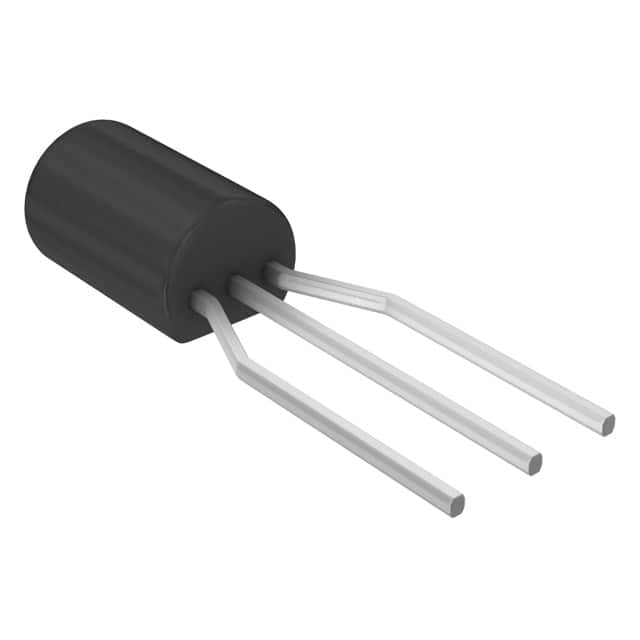Consulte las especificaciones para obtener detalles del producto.

MPSW45A Transistor
Introduction
The MPSW45A is a type of transistor that belongs to the category of bipolar junction transistors (BJTs). It is commonly used in electronic circuits for amplification and switching purposes. This entry provides an overview of the MPSW45A, including its basic information, specifications, pin configuration, functional features, advantages and disadvantages, working principles, application field plans, and alternative models.
Basic Information Overview
- Category: Bipolar Junction Transistor (BJT)
- Use: Amplification and Switching
- Characteristics: High current gain, low noise, and high frequency capability
- Package: TO-92
- Essence: Silicon NPN Epitaxial Planar Transistor
- Packaging/Quantity: Typically available in reels or tubes containing multiple units
Specifications
- Collector-Base Voltage (VCBO): 60V
- Collector-Emitter Voltage (VCEO): 45V
- Emitter-Base Voltage (VEBO): 6V
- Collector Current (IC): 500mA
- Power Dissipation (PD): 625mW
- Transition Frequency (fT): 150MHz
Detailed Pin Configuration
The MPSW45A transistor has three pins: 1. Collector (C) 2. Base (B) 3. Emitter (E)
Functional Features
- High current gain (hFE)
- Low noise
- High frequency capability
- Fast switching speed
Advantages and Disadvantages
Advantages
- High current gain allows for efficient signal amplification
- Low noise makes it suitable for sensitive electronic applications
- High frequency capability enables use in high-speed circuits
Disadvantages
- Limited maximum collector current compared to some other transistors
- Relatively low collector-emitter voltage rating
Working Principles
The MPSW45A operates based on the principles of amplification and control of current flow. When a small current flows into the base terminal, it controls a larger current flowing between the collector and emitter terminals, allowing for signal amplification or switching functions.
Detailed Application Field Plans
The MPSW45A transistor finds applications in various electronic circuits, including: - Audio amplifiers - Signal processing circuits - Switching circuits - Oscillator circuits - RF amplifiers
Detailed and Complete Alternative Models
Some alternative models to the MPSW45A include: - BC547 - 2N3904 - 2N2222 - PN2222
In conclusion, the MPSW45A transistor is a versatile component widely used in electronic circuits for amplification and switching. Its high current gain, low noise, and high frequency capability make it suitable for a range of applications across different industries.
[Word count: 410]
Enumere 10 preguntas y respuestas comunes relacionadas con la aplicación de MPSW45A en soluciones técnicas
What is MPSW45A?
- MPSW45A is a high voltage NPN transistor commonly used in electronic circuits for amplification and switching applications.
What are the typical applications of MPSW45A?
- MPSW45A is often used in audio amplifiers, power supplies, motor control circuits, and high voltage switching applications.
What is the maximum voltage and current rating for MPSW45A?
- The maximum collector-emitter voltage (VCEO) is 300V, and the maximum collector current (IC) is 500mA.
Can MPSW45A be used for low voltage applications?
- While MPSW45A is designed for high voltage applications, it can also be used in low voltage circuits with appropriate biasing and current limiting.
What are the key specifications to consider when using MPSW45A in a circuit?
- Key specifications include VCEO, IC, hFE (current gain), and power dissipation ratings.
How should MPSW45A be connected in a typical amplifier circuit?
- In an amplifier circuit, MPSW45A is typically connected in a common emitter configuration with appropriate biasing resistors and coupling capacitors.
What are the thermal considerations when using MPSW45A in high power applications?
- Proper heat sinking and thermal management are essential for high power applications to ensure that the transistor operates within its temperature limits.
Can MPSW45A be used for pulse-width modulation (PWM) applications?
- Yes, MPSW45A can be used in PWM applications where high voltage switching is required, such as in motor control and power supply circuits.
Are there any common failure modes associated with MPSW45A?
- Common failure modes include overvoltage stress, overcurrent conditions, and excessive heating leading to thermal breakdown.
What are some alternative transistors that can be used if MPSW45A is not available?
- Alternatives include similar high voltage NPN transistors such as MPSW42, MPSW56, and 2N5551, but it's important to check their specifications and pin configurations before substitution.

